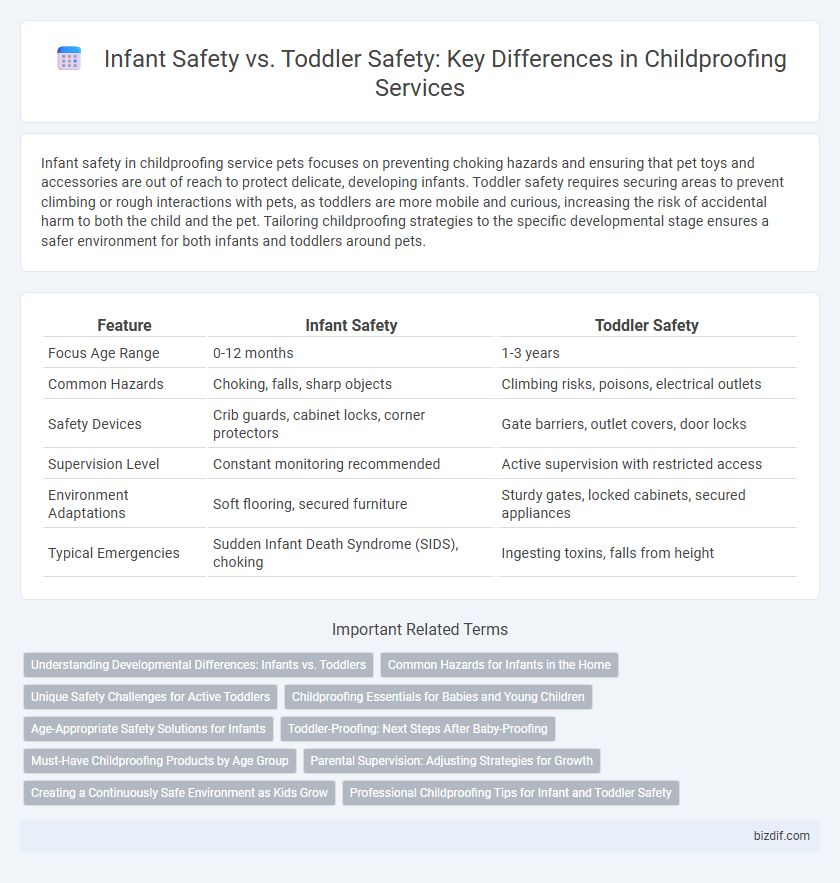Infant safety in childproofing service pets focuses on preventing choking hazards and ensuring that pet toys and accessories are out of reach to protect delicate, developing infants. Toddler safety requires securing areas to prevent climbing or rough interactions with pets, as toddlers are more mobile and curious, increasing the risk of accidental harm to both the child and the pet. Tailoring childproofing strategies to the specific developmental stage ensures a safer environment for both infants and toddlers around pets.
Table of Comparison
| Feature | Infant Safety | Toddler Safety |
|---|---|---|
| Focus Age Range | 0-12 months | 1-3 years |
| Common Hazards | Choking, falls, sharp objects | Climbing risks, poisons, electrical outlets |
| Safety Devices | Crib guards, cabinet locks, corner protectors | Gate barriers, outlet covers, door locks |
| Supervision Level | Constant monitoring recommended | Active supervision with restricted access |
| Environment Adaptations | Soft flooring, secured furniture | Sturdy gates, locked cabinets, secured appliances |
| Typical Emergencies | Sudden Infant Death Syndrome (SIDS), choking | Ingesting toxins, falls from height |
Understanding Developmental Differences: Infants vs. Toddlers
Infant safety requires securing environments to prevent choking, falling, and sudden infant death syndrome risks, emphasizing soft padding and secure crib setups. Toddler safety focuses on managing increased mobility and curiosity by installing gates, securing furniture, and locking hazardous items to prevent injuries from climbing or poisoning. Understanding developmental differences enables tailored childproofing strategies that address specific vulnerabilities at each stage.
Common Hazards for Infants in the Home
Infants face distinct safety risks in the home, such as choking hazards from small objects, suffocation risks with soft bedding, and falls from furniture or stairs. Their limited mobility and inability to communicate distress make these hazards particularly dangerous, necessitating secure crib setups and the removal of loose items. Installing outlet covers and ensuring safe sleep environments are critical steps to protect infants from common household dangers.
Unique Safety Challenges for Active Toddlers
Active toddlers face unique safety challenges compared to infants due to their increased mobility and curiosity, requiring specialized childproofing measures such as securing furniture, installing safety gates, and covering electrical outlets. Unlike infants who primarily need protection from falls and choking hazards, toddlers are more prone to risks like climbing accidents, access to sharp objects, and exploring potentially dangerous household items. Tailored childproofing services focus on addressing these dynamic risks to create a secure environment that supports toddler development and independence.
Childproofing Essentials for Babies and Young Children
Childproofing essentials vary significantly between infant and toddler safety, addressing unique developmental milestones and mobility levels. For infants, securing cribs, outlet covers, and soft corner guards prevents common risks, while for toddlers, installing safety gates, securing furniture anchors, and locking cabinets becomes critical as they explore actively. Prioritizing age-appropriate safety devices tailored to these stages ensures comprehensive protection in the home environment.
Age-Appropriate Safety Solutions for Infants
Infant safety requires tailored childproofing solutions such as securing cribs with breathable bumpers, covering electrical outlets, and installing cabinet locks to prevent access to hazardous materials. Unlike toddlers who are mobile and curious, infants benefit from padded edge guards and soft play areas to minimize injury risks during limited movement phases. Age-appropriate safety measures ensure a secure environment that supports developmental milestones while preventing common household accidents.
Toddler-Proofing: Next Steps After Baby-Proofing
Toddler-proofing builds on baby-proofing by addressing increased mobility and curiosity, requiring reinforced locks on cabinets, secured furniture to prevent tipping, and outlet covers to avoid electrical hazards. Unlike infants, toddlers can open doors and climb, so stair gates must be firmly installed and choking hazards removed from accessible areas. Emphasizing safe play zones and continuous supervision ensures a secure environment tailored to the toddler's developmental stage.
Must-Have Childproofing Products by Age Group
Infant safety requires essential childproofing products such as outlet covers, cabinet locks, and corner guards to prevent injuries from sharp edges and electrical hazards. Toddler safety demands additional measures like stair gates, appliance locks, and furniture anchors to address increased mobility and curiosity. Tailoring childproofing solutions by age group effectively reduces risks and ensures a safer home environment for both infants and toddlers.
Parental Supervision: Adjusting Strategies for Growth
Parental supervision evolves significantly from infant to toddler stages, requiring tailored childproofing strategies to match developmental milestones. Infants demand constant, close monitoring with emphasis on preventing falls, choking hazards, and securing furniture, while toddlers benefit from boundaries that promote exploration yet restrict access to dangerous areas such as stairs, kitchens, and electrical outlets. Effective childproofing integrates age-specific safety devices and vigilant supervision, ensuring a secure environment as the child grows and develops increased mobility and curiosity.
Creating a Continuously Safe Environment as Kids Grow
Infant safety measures emphasize secure crib placements, outlet covers, and soft corner pads to prevent injuries, while toddler safety involves installing stair gates, cabinet locks, and furniture anchors to address increased mobility and curiosity. Creating a continuously safe environment requires regular reassessment of hazards, adapting childproofing solutions as developmental milestones are reached to reduce risks of falls, choking, and poisoning. Implementing age-specific safety strategies ensures that each stage of growth is protected, promoting a secure home atmosphere for both infants and toddlers.
Professional Childproofing Tips for Infant and Toddler Safety
Professional childproofing tips emphasize securing cribs, outlets, and sharp edges to ensure infant safety by preventing choking hazards and falls. For toddler safety, focus on installing safety gates, securing heavy furniture, and using cabinet locks to protect against climbing and accessing dangerous items. Tailoring childproofing measures to developmental stages reduces risks and promotes a safer home environment for both infants and toddlers.
Infant safety vs Toddler safety Infographic

 bizdif.com
bizdif.com